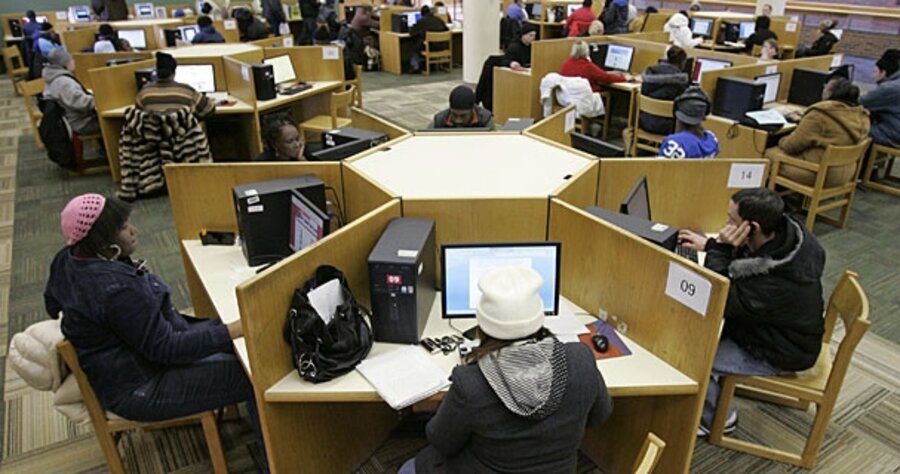Will stimulus work fast enough?
Loading...
| Washington
Given its size and scope, the mammoth economic stimulus bill now moving through Congress may be unprecedented in US history. In that sense it represents a leap into the fiscal unknown.
Many economists agree that some kind of government jolt for the economy is necessary. Job cuts announced this week have only added to this urgency. Caterpillar, the world’s largest manufacturer of construction equipment, announced Monday it is eliminating 20,000 positions, about 18 percent of its workforce. Home Depot said it is shedding 7,000 jobs. Drugmaker Pfizer will cut 8,000.
That said, the stimulus package is a hybrid of short-term job creation efforts and long-term investments, with tax cuts and increases in social programs thrown in. Its macroeconomic impact remains uncertain. One particular question remains open: Will Uncle Sam’s cash begin flowing into the US economy in time to head off further deterioration?
“The economic benefit of the [stimulus] plan critically depends on how quickly the government spending can occur,” said Mark Zandi, chief economist of Moody’s Economy.com, in testimony before the House Budget Committee on Tuesday.
The $825 billion stimulus is virtually certain to pass the House of Representatives this week. The Senate has begun drawing up its version of the bill, and Senate majority leader Harry Reid says the legislation should clear both chambers and land on President Obama’s desk by the beginning of the Presidents’ Day recess, Feb. 16.
The extent to which Republicans will vote for the effort remains a major political issue. Mr. Obama traveled to Capitol Hill Tuesday to meet with GOP lawmakers to try to gain more bipartisan support.
The bill contains about $550 billion in spending and aid to states and $275 billion in tax cuts. Republicans generally have said they believe the effort should tilt more toward tax cuts, which they claim would put money in consumers’ pockets more quickly than spending programs.
“The advertised benefits of many of these spending programs fail to play out in reality,” said Rep. Paul Ryan (R) of Wisconsin, ranking minority member of the House Budget Committee, at Tuesday’s hearing.
But the direct effect of the government’s dollars is only part of the legislation’s anticipated benefit, its boosters argue. At a time when banks have curtailed lending because of liquidity fears, and consumers have shut their wallets because of worries about layoffs, Washington needs to do something to demonstrate leadership and try to dispel the gloom.
“The biggest lift to the economy may come from the psychological boost the [stimulus] program likely will engender,” concluded a Wachovia Economics Group analysis released Jan. 23.
According to Wachovia, the impact of the stimulus will take some time to filter through to the economy. Most of the bill’s infrastructure spending will not kick in until late this year or early 2010. The tax cuts may move a little faster, but are expected to have “only modest impact,” according to Wachovia.
The Congressional Budget Office, in a new report on the state of the US economy, agrees that the macroeconomic impacts of any stimulus program are very uncertain. Some economists are skeptical there will be any significant effects, while others expect very large ones, says the CBO.
“In part, that uncertainty reflects the fact that large fiscal stimulus is rarely attempted,” says the CBO study.
That said, the CBO projects that if the stimulus legislation passes, US gross domestic product (GDP) will be between 1.3 percent and 3.6 percent higher at the end of this year than it otherwise would have been.
The CBO anticipates a similar boost to GDP for 2010. The federal stimulus will produce between 800,000 and 2.1 million jobs this year and as many as 1.5 million additional jobs in 2010, its figures estimate.
“The stimulus will provide a significant boost to output and employment,” said new CBO director Douglas Elmendorf on Tuesday.
The CBO does estimate that money in the bill earmarked for existing programs may flow out relatively slowly, however. This is because the typical process of drafting plans, assessing contracts, and cutting checks can take time.
About 21 percent of the stimulus bill’s total spending will hit the economy this year. About 65 percent will have been spent within the first 18 months of the bill’s enactment, judges the CBO.
“The typical spending rate ... is slower than you might think,” said Mr. Elmendorf.
But that’s OK, the CBO director added, because the economy is expected to remain weak for some time, and continued government spending is thus appropriate.
The stimulus is only partly a short-term package, in any case, some economists note. Much of its spending is investment directed at long-term goals, such as greater renewable energy production and the computerization of medical records.
In the Obama package, “what we used to call stimulus ... has been merged into the broader concept of recovery and investment in future growth,” said Alice Rivlin, a Brookings Institution senior fellow and founding director of the CBO, at the House Budget Committee hearing.
But Ms. Rivlin urged that the investment portion of the bill be offset by corresponding budget cuts or revenue increases, in the name of fiscal responsibility.
This hodgepodge nature of the legislation is what irks GOP lawmakers. They complain that it contains extraneous items such as $600 million for new government cars and millions to refurbish the National Mall.





